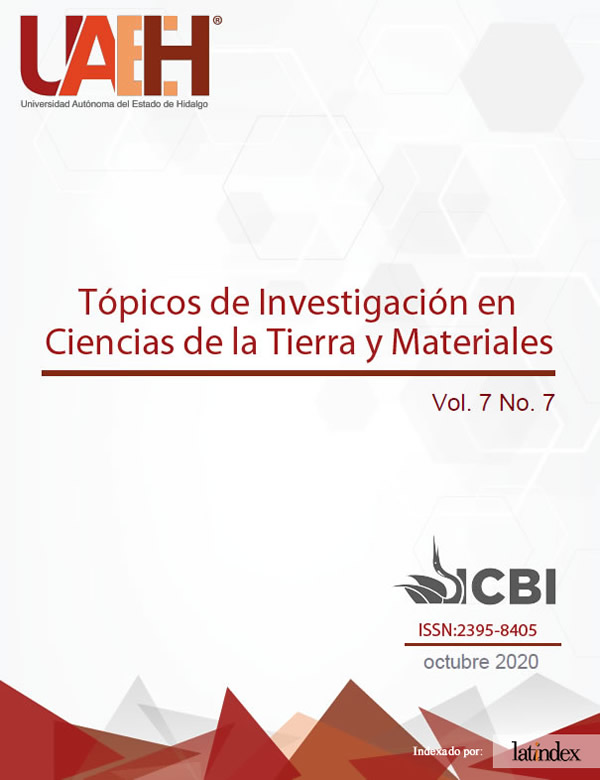Obtaining the ferroelectric phase in BaTiO3 base ceramics doubly doped with rare earths
Abstract
Ceramic materials with a perovskite-like structure such as barium titanate either undoped or doping have been of great interest thanks to its various electrical applications, including; dielectric capacitors, resistors termal sensors, multilayer capacitors and others. The characteristics of this type of materials are determined by its microstructure and its chemical composition, these variables are determined by the synthesis process, the quality of the precursor materials and the addition of dopants. The objetive of this work is to sinter solid solutions of the type Ba1-3XGd2XTi1-3XEu4XO3, using high purity precursors at concentrations of x equal to 0.1%, 0.15%, 0.3% and 0.6% in weigh, in order to obtain a ferroelectric phase doped with 〖Gd〗^(3+) and Eu^(3+). Power mixes were sintered at 1300 °C for 6 hours. Microestructural evolution was characterized by x ray diffraction and scanning electron microscopy. The results showed evidence of the structural evolutions, of a ferroelectric phase (tetragonal).
Downloads
References
Pavlovic VP, Nikolic MV, Nikolic Z, Brankovic G, Zivkovic Lj, Pavlovic VB y Ristic MM. Microstructural evolution and electric properties of mechanically activated BaTiO_3 ceramics. Journal of the European Ceramic Society 2007; 27: 575 – 579.
Rahaman, Ceramic processing and sintering, New York: Marcel Dekker, 2003.
George A, Rossetti Jr y Eric C. Stress induced shift of the Curie point in epitaxial lead titanaete films. Applied Physics Letters 1991; 59: 2524 – 2526.
Pavlovic VP, Stojanovic BD, Pavlovic Lj, Zivkovic y Ristic MM. Low temperature sintering of mechanically activated 〖BaCO〗_3 - 〖TiO〗_2, Science of Sintering 2002; 34; 73 – 77.
D. L. Zhang. Procesing of avanced materirials using high - energy mecanical milling. Progress in Materials Science 2004; 49; 537 - 560.
Chemical Book Inc., Chemical Book. [En línea]. Available: https://m.chemicalbook.com/ProductIndex_EN.aspx. [Último acceso: 15 04 2020].
Wiench K. Acute and chronic effects of nano- and non-nanoscale 〖TiO〗_2and ZnO particles on mobility and reproduction of the freshwater invertebrate Daphnia magna. Chemosphere 2009; 79: 1356 – 1365.
Merck. KGaA. Merck. [En línea]. Available: https://www.sigmaaldrich.com/catalog/product/aldrich/ [Último acceso: 15 04 2020].
Kumari A, Kumar V, Kumar K. Yellow–orange upconversion emission in 〖Eu〗^(3+) - 〖Yb〗^(3+) codoped BaTiO_3 phosphor. Spectrochimica Acta Part A: Molecular and Biomolecular Spectroscopy 2014; 127: 98 – 101.
Lu DY, Ogata T, Unuma H, Li XC, Li NN, Sun XY. Self-compensation characteristics of Eu ions in BaTiO_3. Solid State Ionics 2011; 201: 6 – 10.
Lu DY, Cui SZ, Liu QL, Sun XY. Dielectric properties and defect chemistry of barium titanate ceramics co-doped R and Dy ions (R = Eu, Gd, Tb). Ceramics International 2016.
Lu DY y Liang Y. Valence states and dielectric properties of fine-grained BaTiO_3 ceramics co-doped with double valence-variable europium and chromium. Ceramics International 2018.
Song R, Zhao Y, Li W, Yu Y, Sheng J, Li Z, Zhang Y, Xia H y Fei WD. High temperature stability and mechanical quality factor of donor-acceptor co-doped BaTiO_3 piezoelectrics. Acta Materialia 2019; 181: 200 – 206.
Zhang YM, SUN XY y Lu DY. Effects of Cerium Doping at Ti Sites and Europium Doping at Ba Sites on Dielectric Properties of BaTiO_3. Ceramics Chemistry Res. Chinese U. 2006; 22: 515 – 519.












